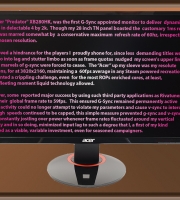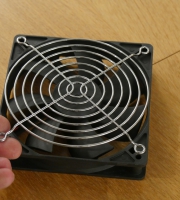


Voice of Slight logic: Who are you trying placate? People who didn’t buy a 970 but were privy to the RAM gate scandal, or betrayed supporters who spent $400 and might still have a cool grand set aside for charity?
Nvidia Apologist: Either suits us. Shall I continue or are we to resort to barbed bitchiness?
Voice of Slight Logic: Carry on.
Nvidia Apologist: Much obliged. Four gigabytes is essential, though any enthusiast frequenting this market would probably have more. However, in order to ensure all 12 gigs of the Titan’s frame buffer can provide optimal functionality, we recommend 24 gigs of system RAM.
Voice of Slight Logic: I can’t believe what I’m hearing. A desperate attempt to pour water RAM gate and you’re now telling us we can’t wholly utilize the resources of a card three times more expensive unless we shell out a ton more on memory?
Nvidia Apologist: I guess that depends on how much you already have….don’t punch me that was a joke.
Voice of Slight Logic: Where the hell is this recommendation on the box?
Nvidia Apologist: It’s on our site and in the manual.
Voice of Slight Logic: But not on the box, why?
Nvidia Apologist: Because it’s not compulsory
Voice of Slight Logic: If it were on the packaging don’t you think your customers might postpone that decisive click? Those are the specs that e-tailers list.
Nvidia Apologist: Unlikely, all the reviews I’ve read were based on 16 gig rigs and divulged no complications whatsoever.
Voice of Slight Logic: Maybe none of their benchmarks exploited all the Titan’s memory
Nvidia Apologist: Precisely! And barely any applications do, though on those isolated exceptions, fear not, your system won’t crash, your card won’t expire, everything won’t grind to a halt but speed might be compromised to an extent depending on the rest of your hardware.
Voice of Slight Logic: This is depressing, really depressing. Will you ever be utterly truthful about your products?
Nvidia Apologist: It’s not our fault. You can blame Gates and his cronies for this one. It relates arcane coding dating all the way back to windows 3.1.
Voice of Slight Logic: Ah! Back to finger pointing?
Nvidia Apologist: Let me explain. Recall if you will when brands such as Orchid, Trident, Tseng and 3DFX commanded respect in the graphics industry.
Voice of Slight Logic: You’re making me cry.
Nvidia Apologist: Happy Voodoo memories? Well, in those good old days video RAM was an extravagance, there were many breeds, DRAM, VRAM, EDO RAM and others, though one quality each shared was a comparative rarity to conventional system RAM, which in a typical configuration was four times more abundant. Image data’s primary destination before being delivered to the computer’s display is obviously the video card’s memory. Frames are created, stored in the buffer, then flipped to the screen.
But if the video RAM is wholly occupied, new frames cannot be composed until a proportion of those pre-rendered has been forwarded to the VDU. Hence, to keep the rendering process as seamless as possible and with video ram being such an extreme luxury, Microsoft decided to implement a procedure that automatically generated a swap, or paging file in the system memory, the next fastest medium, to employ as and when the video RAM was fully populated.
The swap file mirrored the amount of video RAM and to this day, it remains active and proportionally fixed. It was highly uncommon for video cards to incorporate quotas of memory that even approached those of their host system, hence there was no danger of the latter’s being filled to capacity, even when the swap file was being utilized. But consider the situation now. A 12 gig card equates to a 12 gig swap file, which in a system with 16 gigs of RAM, would leave 4 for everything else once the video card’s frame buffer began to overflow. A much finer margin bearing in mind OS overhead and a plethora of background tasks, hence our recommendation.
Voice of Slight Logic: Hang on a second. What if your system memory doesn’t double your VRAM or the page file is expended? Do we get lock-ups and BSODs?
Nvidia Apologist: Very good questions. In the first instance, Microsoft’s process allocates further space on your hard disk to compensate, ensuring the proportions of the page file reflect those of your video memory. Irrespective of whether your RAM doubles your VRAM once the former is full, Windows will begin to assign pre-rendered images to the hard drive as an absolute last resort, in order to ensure the GPU can continue to generate new frames.
Voice of Slight Logic: Which could cause instabilities due to hard drives being the slowest of all three storage options?
Nvidia Apologist: Exactly. But I assure you it’s nothing to worry about. The vast majority of software barely requires 4 gigs. The most advanced games in Ultra HD and surround with eyefuls of surgery decadence might stretch to 7. In any case, there are plenty of things you can do to prepare for a frame-flood. Close down any TSR garbage. Grab an SSD and make sure your page file is allocated to that instead of a mechanical drive. If and when you upgrade your RAM, buy the highest frequency modules you can. These measures will help minimize any performance decline precipitated by the slower forms of storage.
Voice of Slight Logic: But I have friends who’ve been using R9s, 980s and even Mark 1 Titans in rigs with only 8 gigs installed, that would make them vulnerable to this problem, yet their frame rates don’t suddenly dive off a cliff.
Nvidia Apologist: At last your beginning to understand. What does that tell you? This process has been an intrinsic element in Windows for decades and its undesired ramifications are a threat to everyone, yet your friends have never been troubled by them. What about you? Have you noticed any ominous symptoms?
Voice of Slight Logic: I get the odd stutter.
Nvidia Apologist: Who doesn’t? I’ll bet none of you has exceeded your VRAM allowance and if you did, 8 gigs of RAM for a 4 or even a 6 gig frame buffer would be more than enough in reserve to avoid the hard drive being called into play and potentially inducing lag. We actually recommended 12 gigs for the original Titan , but honestly, these references are only intended to represent our formal acknowledgement of the issue, just in case people are planning to harness every last byte.
Voice of Slight Logic: You know, this is hauntingly reminiscent of RAM gate.
Nvidia Apologist: It couldn’t be more different, that inhibition was by design, this one is by default and in no way relates to us. Every video card, past present and future was is and will be subject to the same limitation that is, unless Microsoft provides a fix. We build GPUs, not operating systems. As I said, you really needn’t fret.
Games won’t devour that much VRAM for years by which time, you’ll have probably upgraded your system RAM for a multitude of other reasons. Let me put this another way. Why does any replace their video card? In laymen’s terms, to increase speed and smoothness at higher resolutions. What helps us achieve these things? A faster GPU and bigger frame buffer. When we’re considering any upgrade, what is our state of mind? Are we thinking, I’ll get by with the absolute minimum?”. Unlikely. Especially if we’re a a high-end user. Some decent headroom is essential to guarantee a consistent quality of service, correct?
Voice of Slight Logic: I wonder where we’re going here..
Nvidia Apologist: For instance, if you buy 16 gigs of RAM, you’ll likely be using 12 to 14 99 percent of the time. Nonetheless, the knowledge you have that little extra in reserve for those exceptionally rare occasions is comforting, even if they never come to pass.
Voice of Slight Logic: Think I’m about to find out.
Nvidia Apologist: Likewise, If you purchase a new graphics card, your going to want to ensure it has enough VRAM to accommodate every game or app you’re intending to run, because if it doesn’t, regardless of the quantity and bandwidth of your system RAM, you will suffer a hit as soon as paging is initiated. The fastest modules you can buy still operate at half the frequency of top tier video RAM.
Voice of Slight Logic: Here it comes.
Nvidia Apologist: So when the Titan X’s 12 gigs are no longer sufficient to serve without assistance, you enthusiasts will have upgraded to a card with considerably more, hence, the chances of this issue ever affecting you are as remote as the Orion Nebula.
Voice of Slight Logic: Which is what you’re banking on right? Nothing limits damage better than time, especially in this business.
Nvidia Apologist: It’s simple. If you don’t like our products, you needn’t buy them, but I’m afraid my master knows you better than you do yourself. If you’re troubled by that, feel free to vent your frustrations before you make that inevitable donation.
Voice of Slight Logic: This is a very dangerous game you’re playing.
Nvidia Apologist: Wrong. You play the games, we provide the means.
Voice of Slight logic: Which brings us gracefully onto my next question
Nvidia Apologist: I can barely contain my excitement.